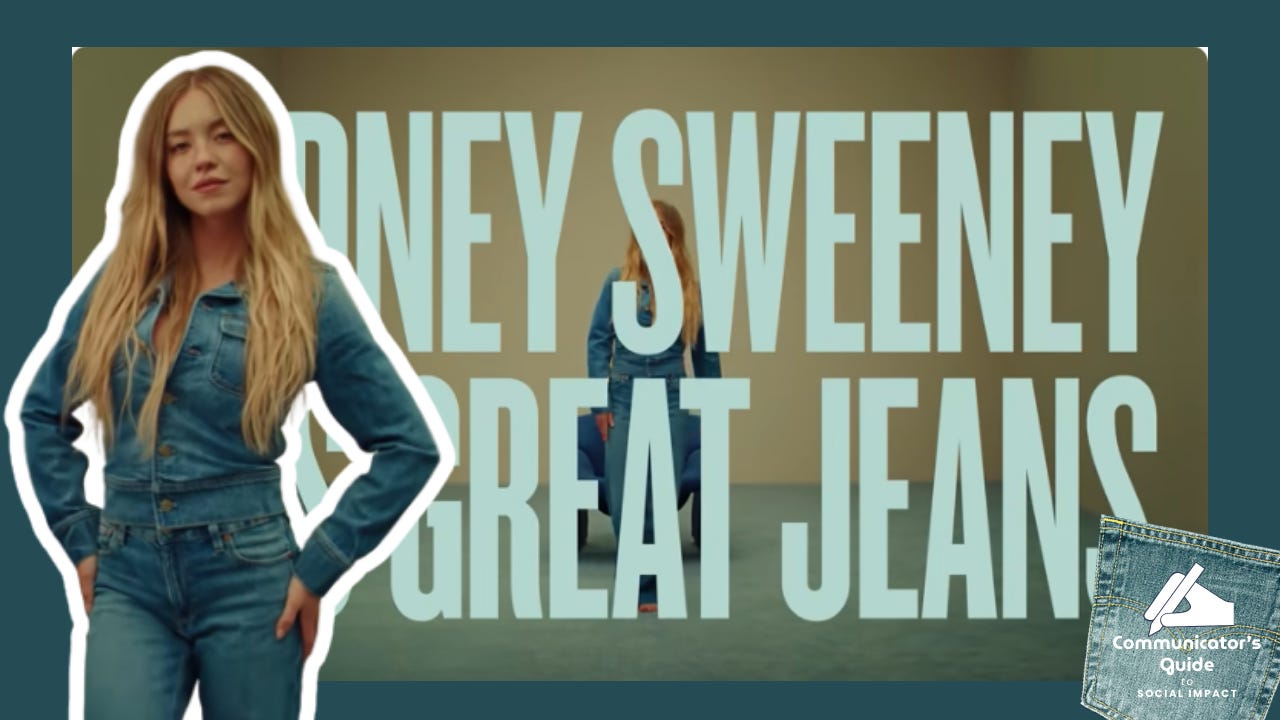How a Jeans Ad Reveals the Complexity of Messaging (and What We Can Learn)
How American Eagle’s wordplay serves as a case study on mindful messaging. Read more!

If you’ve spent time on social media lately, you might have noticed the recent controversy stemming from the American Eagle ad campaign on jeans. And if not, don’t worry. I’ll catch you up.
You might be thinking: “Why are we talking about a company that sell jeans in a social impact newsletter?” Well, it turns out that even something as simple as selling clothing can become a powerful case study in how communication affects society.
The American Eagle x Sydney Sweeney Example
American Eagle recently ran an ad featuring Sydney Sweeney, the actress from Euphoria and season 1 of The White Lotus. In the ad, Sweeney says, “Sydney Sweeney has great jeans,” playing on the homophone between “jeans” and “genes.”
Upon first watch, I didn’t think much of the ad. But its reception revealed deeper meaning and compelling social critiques. Here are some of the controversies that came out of this ad:
Some pointed out that the wordplay in the ad (“Jeans are passed down from parents to offspring, often determining traits like hair color, personality, and even eye color. My jeans are blue.”) promotes eugenics.
Some denounced the hyper-sexualized nature of an ad, especially for a company selling back-to-school clothing to teenage girls.
Some found the ad to have striking similarities to a past sexualized Calvin Klein jeans ad that stared Brooke Shields, who was 15-years-old at the time.
I won’t spend too much time dissecting all the controversies here, but you can check out this article reported by NPR to get more details.
Once the social media sphere erupted around this campaign, American Eagle later posted a response on Instagram to address some of the backlash about eugenics, stating that this was not their intent.
How could this have been avoided?
I found this ad campaign to be particularly fascinating from a messaging angle. Cases like the American Eagle ad show how messaging that may seem harmless to the creators (I’m assuming) can have unexpected, negative social consequences, highlighting the importance of careful wording and awareness of nuance. After reviewing this ad campaign, here are some of the questions that came to mind:
How can wordplay unintentionally cause harm?
Who might feel excluded or alienated by a message?
What brand values are being communicated through an ad campaign?
How do we predict and mitigate negative social impact before a message goes live?
These are questions that we, as communicators and marketers, think about regularly. While not exhaustive, here are some practical steps one could take to avoid a controversy like this:
Think through alternative meanings of your words and visuals.
Consider how different audiences might interpret your message.
Ask if anyone could feel excluded, mocked, or harmed by your communication.
Identify what values you want to champion and ensure that message captures those values.
Test messages with diverse perspectives within the target audience before launch.
It’s important to also note: As communicators, we are not immune to mistakes. At times, our words or actions may unintentionally cause harm. When that happens, it is essential to acknowledge the impact, take responsibility, and apply effective crisis communication strategies to address the situation and rebuild trust.
The Gap x Katseye Example
Interestingly, Gap released a jeans ad soon after that I believe is worth talking about. It had the opposite effect of the American Eagle one. They partnered with Katseye, a global girl group formed on a reality show called Dream Academy in 2023. The group, made up of six girls with different ethnic backgrounds, performed a dance number with a diverse dance crew, all featuring different denim Gap outfits.
Why does this work?
The reception of this ad has been positive for various reasons. From my analysis of the ad campaign’s messaging, here are four reasons that stood out to me:
Visual storytelling: The dance transcended language, making the ad enjoyable for a global audience.
Inclusivity: By featuring dancers of different ethnicities, the ad showed that Gap jeans are for everyone.
Utility: Demonstrating how the jeans held up through energetic dance moves showcased their durability and quality in a way that felt more authentic and appropriate than sexualized imagery.
Transparency: Gap posted behind-the-scenes content, which gave audiences a glimpse into the creative process.
Gap’s ad campaign considered social impact, whether consciously or not. It reinforced a positive message: jeans—and by extension, the brand—can be a celebration of unity.
Why This Matters for Social Impact Communicators
American Eagle probably didn’t intend to spark controversy, but the episode is a clear reminder: word choice and imagery matter. In public health and social impact communication, the stakes are even higher:
A poorly framed public health message can alienate communities or fuel misinformation.
Creative campaigns need to consider how audiences might interpret words, visuals, and symbols.
Testing messages with diverse groups isn’t just a nice-to-have. It’s essential.
Every communication effort carries a social impact. By learning from both the American Eagle misstep and Gap’s inclusive example, we can create messages that engage, resonate, and ultimately make our communities stronger.



